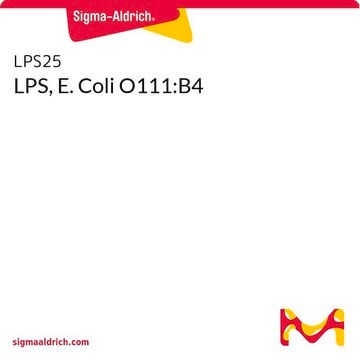Frozen aliquots can be stored up to 2 years. For more information, please see the link below:
https://www.sigmaaldrich.com/technical-documents/protocol/clinical-testing-and-diagnostics-manufacturing/bacteriology/lipopolysaccharides
L4516
Lipopolysaccharides from Escherichia coli O127:B8
BioXtra, suitable for cell culture, γ-irradiated
Synonym(s):
LPS
Select a Size
About This Item
Recommended Products
biological source
Escherichia coli (O127:B8)
Quality Level
sterility
γ-irradiated
product line
BioXtra
form
lyophilized powder
purified by
gel-filtration chromatography
technique(s)
cell culture | mammalian: suitable
impurities
<1% Protein (Lowry)
solubility
H2O: 5 mg/mL, slightly hazy
storage temp.
2-8°C
Looking for similar products? Visit Product Comparison Guide
Application
- to study the LPS-induced macrophage survival in mice[1]
- to elicit the secretion of cytokines by cattle PBMC[2]
- to study apoptosis of highly susceptible macrophage cells in a LPS-induced proinflammatory environment[1]
- to perform autophagy assay in BV2 and BV2-LC3 cells[3]
- for stimulation of human monocytes, macrophages and mouse microglia cells[4][5][6][7]
- to induce pentraxin-3 expression in 293T cells[8]
Biochem/physiol Actions
Reconstitution
Other Notes
related product
Signal Word
Danger
Hazard Statements
Precautionary Statements
Hazard Classifications
Acute Tox. 2 Oral
Storage Class Code
6.1A - Combustible acute toxic Cat. 1 and 2 / very toxic hazardous materials
WGK
WGK 3
Flash Point(F)
Not applicable
Flash Point(C)
Not applicable
Choose from one of the most recent versions:
Certificates of Analysis (COA)
Don't see the Right Version?
If you require a particular version, you can look up a specific certificate by the Lot or Batch number.
Already Own This Product?
Find documentation for the products that you have recently purchased in the Document Library.
Customers Also Viewed
Articles
Explore the structure, function, and diverse applications of Lipopolysaccharides. Discover their role in bacteria, serological specificity, and research potential.
-
Once reconstituted what is the stability at -20C for the LPS product L4516-1M?
1 answer-
Helpful?
-
-
Can LPS bind to plastics (ex. 1.5 mL microtube) even when LPS solution is frozen stored at -20℃? I store LPS solution at 0.05mg/mL in -20℃ now.
1 answer-
LSP is less likely to stick to plastics than glass, however very low concentrations (<0.1 mg/mL in water), LPS tends to stick to containers made
of certain types of glass or plastic. To minimize, prepare stock solutions of at least 1 mg/mL. If the LPS concentration is >1 mg/mL, adsorption to the sides of the vial is
negligible. For solutions stored in glass, vortexing for 30 minutes following thaw is recommended to redissolve. This may be useful for dilute solutions in plastic, as well. Surfaces (glass and plastics) may be salinized to reduce adherence.See Sigmacote, SL2:
https://www.sigmaaldrich.com/product/sigma/sl2For additional information, see the link below to review the Lipopolysaccharides product information page:
https://www.sigmaaldrich.com/technical-documents/protocol/clinical-testing-and-diagnostics-manufacturing/bacteriology/lipopolysaccharidesHelpful?
-
Active Filters
Our team of scientists has experience in all areas of research including Life Science, Material Science, Chemical Synthesis, Chromatography, Analytical and many others.
Contact Technical Service


